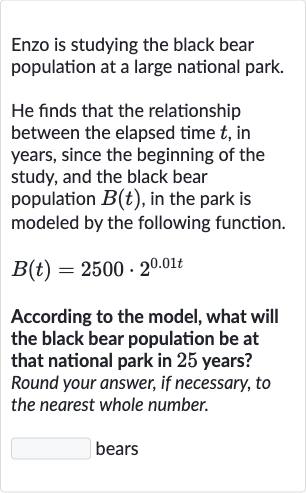AI tutor
Welcome to Bytelearn!
Let’s check out your problem:

Enzo is studying the black bear population at a large national park.He finds that the relationship between the elapsed time , in years, since the beginning of the study, and the black bear population , in the park is modeled by the following function.According to the model, what will the black bear population be at that national park in years? Round your answer, if necessary, to the nearest whole number.bears
Full solution
Q. Enzo is studying the black bear population at a large national park.He finds that the relationship between the elapsed time , in years, since the beginning of the study, and the black bear population , in the park is modeled by the following function.According to the model, what will the black bear population be at that national park in years? Round your answer, if necessary, to the nearest whole number.bears
- Identify values and function: Identify the values of and the function .Elapsed time () = years
\newline B(t) = .2500 2500 2 2 0 0 01 01 - Substitute value into function: Substitute the value of
t t B ( t ) B(t) \newline B ( 25 ) = 2500 × 2 ( 0.01 × 25 ) B(25) = 2500 \times 2^{(0.01 \times 25)} - Calculate the exponent: Calculate the exponent.
\newline 0.01 × 25 = 0.25 0.01 \times 25 = 0.25 - Calculate
2 2 2 0.25 2^{0.25} \newline 2 0.25 ≈ 1.189207115 2^{0.25} \approx 1.189207115 - Multiply result by
2500 2500 2500 2500 B ( 25 ) B(25) \newline B ( 25 ) = 2500 × 1.189207115 B(25) = 2500 \times 1.189207115 \newline B ( 25 ) ≈ 2973.0177875 B(25) \approx 2973.0177875 - Round result to nearest whole number: Round the result to the nearest whole number.
B ( 25 ) ≈ 2973 B(25) \approx 2973
More problems from Compound interest: word problems
QuestionGet tutor help
QuestionGet tutor help
QuestionGet tutor help
QuestionGet tutor help
QuestionGet tutor help
QuestionGet tutor help
QuestionGet tutor help
QuestionGet tutor help
QuestionGet tutor help
